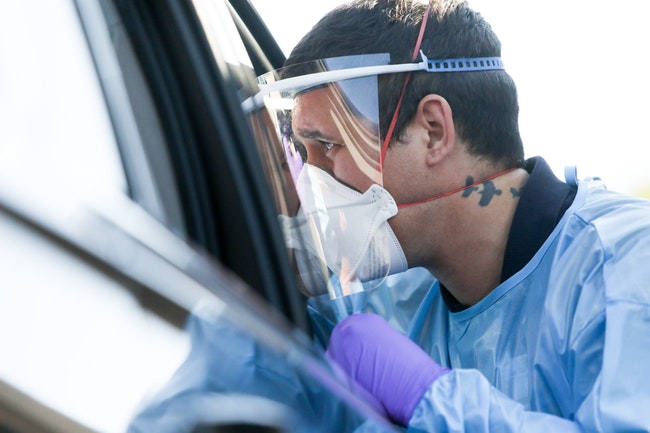
Austin Griffith, a medic with Woodburn Ambulance Service, administers a Covid test during a free drive-through testing clinic on Tuesday, Aug. 25. (Amanda Loman/Salem Reporter)
Oregon said Tuesday it won’t approve widely adopted technology that would allow smartphone users to be notified if they are potentially exposed to COVID-19, saying the health authority has “all available resources” assigned to vaccine management.
The announcement ended suspense over a project first announced six months ago but repeatedly delayed, with limited explanation. Oregon is one of just four states along or west of the Continental Divide that hasn’t adopted the technology.
The state for months had said it was studying the program’s efficacy after a pilot project at Oregon State University, but officials were initially unable to produce documentation of their analysis.
In a news release Tuesday, the health authority said it “decided to pause the ongoing planning” for the application to “focus on vaccinations and other priority efforts to end the COVID-19 pandemic.”
Officials wrote that discussions with public health departments and other community groups highlighted the benefits and costs of the notification app.
But they opted not to move forward, citing “the intensive efforts state and local health officials would need to undertake to promote the app and address likely gaps in its adoption across Oregon’s diverse communities, as well as the added contact tracing demands full adoption would place on county public health staff.”
After announcing it would “pause” its plans Tuesday, the state did provide a two-page document to The Oregonian/OregonLive in response to a public records request.
“The OSU pilot was not able to collect data to either prove or disprove its effectiveness for Oregon citizens,” the undated document reads, adding: “Given current resource constraints and the focus on the vaccination effort, the recommendation is to discontinue the effort at this time.”
Nearly 12,500 students and staff at Oregon State downloaded or activated the exposure notification system, which the state said was a 20% adoption rate out of 40,000 people.
But it’s unclear if that rate is reflective of the situation, as the university reported enrollment of only 23,000 at its Corvallis campus this fall – and some portion of those students were learning remotely.
In fact, there were no instances where a student or staff member received a notification for potential COVID-19 exposure because there were a “relatively small number of people on campus,” and “relatively few cases detected on campus” during the pilot because “most students were taking classes online,” according to the two-page report.
What’s more, none of the known cases at Oregon State University involved a person who had enabled the notification app to alert others.
The technology already exists on Apple smartphones but must be downloaded for Android users. The system won’t work for users, however, without first being activated by the Oregon Health Authority.
Health authority officials in December said that a January rollout was imminent. In January, the app was accidentally made available, which the state said was an error. The same month, health leaders said they were still studying the program and later said they eyed a spring rollout.
The health authority did not reflect that reality in its news release, instead highlighting that “approximately two dozen states have chosen not to deploy smartphone-based apps at this time.”
This story published with permission as part of the AP Storyshare system. Salem Reporter is a contributor to this network of Oregon news outlets.









